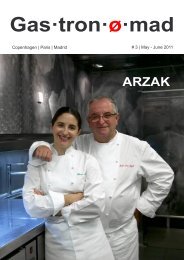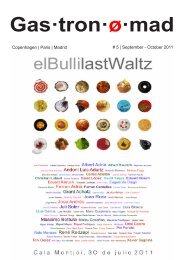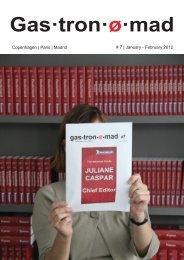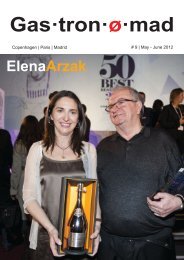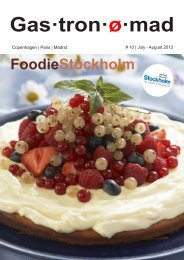Gastronomad #8 March - April 2012
You also want an ePaper? Increase the reach of your titles
YUMPU automatically turns print PDFs into web optimized ePapers that Google loves.
GASTRØ·CULTUR<br />
Abstract<br />
Available online at www.sciencedirect.com<br />
International Journal of Gastronomy and Food Science 1 (<strong>2012</strong>) 15–30<br />
Sous vide cooking: A review<br />
Douglas E. Baldwin<br />
University of Colorado, Boulder, CO 80309-0526, United States<br />
Received 3 October 2011; accepted 1 November 2011<br />
Available online 7 December 2011<br />
International Journal of<br />
Gastronomy and<br />
Food Science<br />
Sous vide is a method of cooking in vacuumized plastic pouches at precisely controlled temperatures. Precise temperature control<br />
gives more choice over doneness and texture than traditional cooking methods. Cooking in heat-stable, vacuumized pouches improves<br />
shelf-life and can enhance taste and nutrition. This article reviews the basic techniques, food safety, and science of sous vide cooking.<br />
& 2011 AZTI-Tecnalia. Production and hosting by Elsevier B.V. All rights reserved.<br />
Keyword: Sous vide cooking<br />
Introduction<br />
Sous vide is French for ‘‘under vacuum’’ and sous vide<br />
cooking is defined as ‘‘raw materials or raw materials with<br />
intermediate foods that are cooked under controlled<br />
conditions of temperature and time inside heat-stable<br />
vacuumized pouches’’ (Schellekens, 1996).<br />
Food scientists have been actively studying sous vide<br />
processing since the 1990s (cf. Mossel and Struijk, 1991;<br />
Ohlsson, 1994; Schellekens, 1996) and have mainly been<br />
interested in using sous vide cooking to extend the shelflife<br />
of minimally processed foods—these efforts seem to<br />
have been successful since there have been no reports of<br />
sous vide food causing an outbreak in either the academic<br />
literature or outbreak databases (Peck et al., 2006). Chefs<br />
in some of the world’s top restaurants have been using<br />
sous vide cooking since the 1970s but it was not until the<br />
mid-2000s that sous vide cooking became widely known<br />
(cf. Hesser, 2005; Roca and Brugue´s, 2005); the late-2000s<br />
and early-2010s have seen a huge increase in the use of<br />
sous vide cooking in restaurants and homes (cf. Baldwin,<br />
2008; Keller et al., 2008; Blumenthal, 2008; Achatz, 2008;<br />
E-mail address: sousvide@douglasbaldwin.com<br />
URL: http://www.douglasbaldwin.com/sous-vide.html<br />
Nore´n and Arnold, 2009; Baldwin, 2010; Potter, 2010;<br />
Kamozawa and Talbot, 2010; Myhrvold et al., 2011).<br />
Sous vide cooking differs from traditional cooking<br />
methods in two fundamental ways: the raw food is<br />
vacuum-sealed in heat-stable, food-grade plastic pouches<br />
and the food is cooked using precisely controlled heating.<br />
Vacuum-sealing has several benefits: it allows heat to be<br />
efficiently transferred from the water (or steam) to the food;<br />
it increases the food’s shelf-life by eliminating the risk of<br />
recontamination during storage; it inhibits off-flavors from<br />
oxidation and prevents evaporative losses of flavor volatiles<br />
and moisture during cooking (Church and Parsons, 2000);<br />
and reduces aerobic bacterial growth—this results in especially<br />
flavorful and nutritious food (Church, 1998; Creed,<br />
1998; Garcıá-Linares et al., 2004; Ghazala et al., 1996; Lassen<br />
et al., 2002; Schellekens, 1996; Stea et al., 2006).<br />
Precise temperature control has more benefits for chefs<br />
than vacuumized packaging does: it allows almost-perfect<br />
reproducibility (Keller et al., 2008; Blumenthal, 2008;<br />
Achatz, 2008); it allows greater control over doneness<br />
than traditional cooking methods (Baldwin, 2008; Nore´n<br />
and Arnold, 2009; Baldwin, 2010; Myhrvold et al., 2011);<br />
food can be pasteurized and made safe at lower temperatures,<br />
so that it does not have to be cooked well-done<br />
to be safe (Baldwin, 2008, 2010); and tough cuts of meat<br />
1878-450X/$ - see front matter & 2011 AZTI-Tecnalia. Production and hosting by Elsevier B.V. All rights reserved.<br />
doi:10.1016/j.ijgfs.2011.11.002<br />
Production and hosting by Elsevier<br />
www.elsevier.com/locate/ijgfs<br />
are discussed in terms of nutritional and health properties of<br />
two different menus from Mugaritz Restaurant.<br />
Materials and methods<br />
Magazines | Revues | Revistas<br />
70 Gastronømad Gastronømad 71<br />
38<br />
Menu design<br />
V. Navarro et al. / International Journal of Gastronomy and Food Science 1 (<strong>2012</strong>) 37–45<br />
The working team of the experimental kitchen from<br />
Mugaritz Restaurant was responsible for defining and designing<br />
the dishes. The selection of the final recipes and menus was<br />
made attending to guest demands and sensory preferences.<br />
Recipes are described in Supplementary material. Final presentation<br />
of a dish is shown in the figures, for example,<br />
A pasta of amaranth, baby langoustine tails, is shown in Fig. 1.<br />
Nutritional composition analysis of dishes and menus<br />
A total of 21 dishes conforming to two different menus<br />
(Sustraiak and Naturan) were analyzed. All dishes were<br />
prepared in duplicate and weighed. Each dish was then<br />
completely homogenized and a representative sample was<br />
used for nutritional composition analysis. Macro and<br />
micronutrients as well as certain bioactive compounds were<br />
determined. Samples were analyzed according to the Association<br />
of Official Analytical Chemists methods (AOAC,<br />
2002): moisture (AOAC 950.46), ash (AOAC 923.03) and<br />
protein content (AOAC 954.01). The measurement of<br />
reducing sugars was expressed as invert sugar or dextrose<br />
equivalent by the Luff–Schoorl method (Lees, 1968).<br />
Total lipids were evaluated by extraction with chloroform/<br />
methanol/water following the Bligh & Dyer method with<br />
minor modifications (Bligh and Dyer, 1959). The quantitative<br />
cholesterol content of the samples was determined according<br />
to the Annex V of the European Official Analysis Methods<br />
(European Commission, 1991a). Quantification of the silanised<br />
sterol fraction was carried out by capillary gas chromatography,<br />
on a Hewlett Packard 6890 chromatograph with flame<br />
ionization detector (FID) using a SE-54 capillary column<br />
(30 m 0.25 mm i.d. and 0.25 mm thickness, Supelco). Lipid<br />
extractions from each sample were esterified as described in<br />
Annex X of the European Official Analysis Methods<br />
(European Commission, 1991b). Fatty acid methyl esters<br />
Fig. 1. Presentation of the dish of A pasta of amaranth, baby langoustine<br />
tails. Tender garden leaves. Photograph from Jose Luis Lo´pez de Zubiria.<br />
(FAMEs) were analyzed using a gas chromatograph Hewlett<br />
Packard 5860 equipped with a flame ionization detector 6890<br />
(FID) and a DB-23 fused silica capillary column (60 m 0.25<br />
mm i.d. and 0.25 mm thickness; Agilent Technologies, USA).<br />
Fatty acids were identified by comparison of retention times to<br />
standards and relative quantities were expressed as weight<br />
percent of total fatty acids.<br />
Total dietary fiber (TDF) was analyzed following the official<br />
enzymatic–gravimetric method (AOAC 991.43), total sodium<br />
(Na) and potassium (K) by a flame photometric method<br />
(AOAC 969.23), calcium (Ca) by atomic absorption spectrophotometry<br />
(AOAC 975.03) in a fast sequential atomic<br />
absorption spectrophotometer (model AA240 FS, Varian<br />
Inc., The Netherlands), following the official methods<br />
(AOAC, 2002). The analytical curve was plotted for each<br />
element. All the nutritional composition analyses were done in<br />
duplicate and the results shown in the tables are the means.<br />
Nutrition and health assessment tools<br />
For the nutrition and health assessment of Mugaritz food<br />
designs, the current legislation on nutrition and health claims<br />
of foodstuffs was utilized. As a consequence, the nutrients of<br />
compulsory declaration for nutritional claims were analyzed.<br />
Total energy was also calculated as indicated by law: energy<br />
(kcal)¼4 (g proteinþg carbohydrate)þ9 (g lipid)þ2 <br />
(g of TDF) (European Commission, 2011).<br />
In order to assess the real contribution of each dish and<br />
menu to the diet, results were expressed considering the<br />
servings given to the customers in the restaurant. This<br />
information allowed the comparison between nutritional<br />
values of all the dishes (per serving) and evaluation of their<br />
contribution to the menu.<br />
In order to convey the relative significance of the<br />
contribution of each dish and menu to a daily diet, the<br />
results were also expressed as a percentage of a Daily<br />
Reference Value (DRV) or Reference Intake (RI). DRVs<br />
or RIs for energy and selected nutrients were those<br />
proposed by the Panel on Dietetic Products, Nutrition<br />
and Allergies of the European Food Safety Authority<br />
(EFSA) for a woman (EFSA, 2009a, 2010a).<br />
In order to highlight their nutritional properties or<br />
potential effects on health, it was also necessary to evaluate<br />
the overall nutritional status of the dish and menu designs.<br />
To that end, dishes were categorized on the basis of their<br />
composition according to a legal proposal of the European<br />
Commission (2009). For each food category, thresholds of<br />
sodium, saturated fat and sugars have been suggested.<br />
Dishes complying with these nutritional criteria would be<br />
justified in making nutrition and health claims according to<br />
food regulations (European Commission, 2006, 2010, 2011).<br />
Thus only those dishes, which did not exceed EFSA<br />
thresholds, were evaluated for nutritional and health claims.<br />
Additionally, the presence of some nutrients (sodium<br />
and cholesterol) and also certain bioactive components<br />
(long chain omega-3, linolenic acid and potassium)<br />
involved in the etiology (formation or prevention) of





